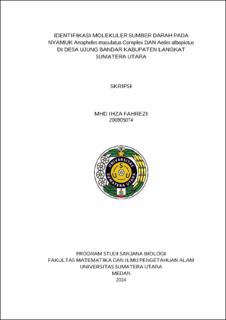Identifikasi Molekuler Sumber Darah pada Nyamuk Anopheles Maculatus Complex dan Aedes Albopictus di Desa Ujung Bandar Kabupaten Langkat Sumatera Utara
Molecular Identification of the Blood Sources of Anopheles Maculatus Complex and Aedes Albopictus at Ujung Bandar Village, Langkat District, North Sumatera

Date
2024Author
Fahrezi, Mhd Ihza
Advisor(s)
Hannum, Saleha
Sinaga, Ledy Afrida
Metadata
Show full item recordAbstract
Malaria and Dengue Fever still remain health polemic in Indonesia. Based on data
from Kementrian Kesehatan, cases of Malaria and Dengue Fever in North Sumatera,
especially at Langkat Regency are still high and stable. Malaria transmitted through
the bite of Anopheles mosquitoes, which one like the Anopheles maculatus complex in
Langkat Regency. Meanwhile, dengue fever caused by Aedes mosquito, like Aedes
albopictus. Understanding the bionomics of mosquito vectors is important to
determine appropriate vector control activities in preventing the transmission of
malaria and dengue fever. One of the bionomics of mosquitoes is the blood feeding
behavior. To determine this blood feeding pattern, it can be done by identify the blood
sources in the mosquito's abdomen by molecular technique, especially using
Polymerase Chain Reaction (PCR). Mosquitoes were collected from Dusun II and V,
Desa Ujung Bandar Village, Langkat District, North Sumatra using the double net
trap method started from August to November 2023 with a total of 12 captures at night
at each place. Mosquitoes were identified by the name of species and the blood status
in the abdomen morphologically, and then followed by molecular analysis in the
Laboratory. Mosquito’s DNA was analyzed by PCR using the Cytochrome Oxidase
subunit I gene through the control animals which were human, dog, cat, chicken,
bovine, wild Boar, and monkey. The PCR products were visualized by electrophoresis
technique and identified according to the DNA band sequences of the seven animals
as the control. Molecular identification of both mosquito species showed that 6 out of
29 specimens of An. maculatus complex had blood and 4 specimens were known to
contain human blood and 2 others contain non-control animals blood. In Ae.
albopictus, 38 out of 45 specimens were identified as containing blood and 29
specimens were found to contain human blood, 5 specimens contained dog blood, and
5 specimens contained of both human and dog blood and 4 others contain non-control
animals blood. The results of this study concluded that blood feeding behavior of An.
maculatus complex was anthropophilic and Ae. albopictus was opportunistic.
Collections
- Undergraduate Theses [984]
